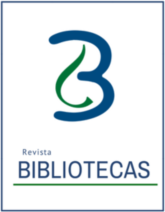Análisis de 5 universidades colombianas con mayor porcentaje de investigaciones publicadas en revistas de primer cuartil según el SIR Iber 2014
DOI:
https://doi.org/10.15359/rb.35-3.1Palabras clave:
bibliometría, informetría, cienciometría, rankings universitarios, revistas científicasResumen
Se realizó un estudio en cinco universidades con mayor porcentaje de publicaciones en revistas de primer cuartil, según el ranking internacional SCImago Institutions Rankings Iberoamerica 2014 (SIR Iber 2014). Los registros procedentes del SIR Iber 2014 fueron exportados a una base de datos y mediante una hoja de cálculo en Excel se elaboraron tablas y gráficos que permitieron hacer recuentos estadísticos, análisis de frecuencias y análisis de cluster. Se hizo una revisión del tamaño de la producción, el impacto científico, la especialización temática y la colaboración entre las universidades en los ámbitos nacional e internacional.
El estudio se realizó a partir de la revisión de los resultados obtenidos en el SIR Iber 2014, complementados con los datos obtenidos en las bases de datos Scopus y WoS, respecto a las primeras cinco universidades colombianas que, en ese año, publicaron más trabajos en revistas de primer cuartil (Q1). Los principales resultados muestran las universidades con mejor posición en el ranking SIR Iber 2014, de acuerdo con los criterios bibliométricos analizados: colaboración internacional, impacto, publicaciones de alta calidad, excelencia y liderazgo científico.
Referencias
Arencibia-Jorge, R., Vega-Almeida, R. L., Chinchilla-Rodríguez, Z., Corera-Álvarez, E. y Moya-Anegón, F. (2012). Patrones de especialización de la investigación nacional sobre Salud. Revista Cubana de Salud Pública, 38 (5). http://dx.doi.org/10.1590/S0864-34662012000500007
Chubb, I. (2007). Distinguishing (Between) Universities. En: Sadlak J. y Nian, L. (eds.) The World-Class University and Ranking: Aiming Beyond Status. Bucarest: UNESCO-CEPES.
Creus, A. (2014). Desarrollo profesional e intercambio de conocimiento en los grandes experimentos científicos. Revista Española de Documentación Científica, 37 (4).
Gonzáles de Dios, J.; Moya, M. y Mateos-Hernández, M. (1997). Indicadores bibliométricos: características y limitaciones en el análisis de la actividad científica. Anales Españoles de Pediatría, Vol. 47 (3)
Knowledge. BiblioSaúde. Recuperado de http://bibliosaude.sergas.es/DXerais/481/COMO%20CALCULAR%20EL%20 CUARTIL%20DE%20UNA%20REVISTA%20CIENT%C3%8DFICA.%20isi%20wEB% 20OF%20kNOWLEDGE.pdf
López, E. (2012). Cómo se cocinan los rankings universitarios. Dendra Médica. Revista de Humanidades, 11 (1).
López, O. y Cordero, A. (2015). Un intento por definir las características generales de las revistas académicas electrónicas. Razón y Palabra. Recuperado de http/www.cem.itesm.mx/publicaciones/logos/libros/index.html
Lopez-Illescas, C., de Moya-Anegón, F. y Moed, H.F. (2011). A ranking of universities should account for differences in their disciplinary specialization. Scientometrics, 88 (2). http://dx.doi.org/10.1007/s11192-011-0398-6
López, S. (2012). Los rankings universitarios. Bases teóricas, metodología y su impacto en la educación superior global. Revista de la educación superior, 51 (161).
Mattar, V.; González, M. y Salgado, L. (2013). Análisis de las universidades colombianas de acuerdo con el ranking SCImago 2010-2012. En MVZ Córdoba 18 (1).
Moed, H.; Moya-Anegón, F.; López-Illescas, C. y Visser, M. (2011). Is concentration of university research associated with better research performance? Journal of Informetrics, 5 (4). http://dx.doi.org/10.1016/j.joi.2011.06.003
Molina-Molina, S. y De Moya-Anegón, F. (2013). Política nacional y visibilidad internacional. El caso colombiano. El Profesional de la Información, 22 (6).
Nian, Y. (2007). Academic Ranking of World Universities: Methodologies and Problems. En: Sadlak J. y Nian, L. (eds.). The World-Class University and Ranking: Aiming Beyond Status. Bucarest: UNESCO-CEPES.
Pérez, Y. (2016). Los rankings y la calidad de la educación superior. Recuperado de http://www.universidad.edu.co/index.php?option=com_content&view=article&id=6747:2016-04-03-17-59-03&catid=36:ensayos-acadcos&Itemid=81
Pinski, G. y Narin, R. (1996). Citation influence for journal aggregates of scientific publications: theory with application to the literatura of physics. Information Processing and management. No. 12. Recuperado de http://sci2s.ugr.es/sites/default/files/files/TematicWebSites/hindex/ PinskiNarin1976.pdf
Plata, J. (2013). Las universidades y la planificación de la investigación y la innovación. Los retos éticos en el nuevo siglo. Memorias. XII Congreso “La Investigación en la Pontificia Universidad Javeriana”. Tercera sesión del simposio sobre fortalezas de investigación, un conversatorio sobre experiencias nacionales en la definición de agendas de investigación.
Principales revistas en donde publican los autores de la Universidad Jorge Tadeo Lozano (2014). Recuperado de Scopus. [Disponible en https://www.scopus.com/search/form.uri?display=basic]
Producción por áreas del conocimiento. Universidad de los andes (2014). Recuperado de Scopus. [Disponible enhttps://www.scopus.com/search/form.uri?display=basic]
Sadlak, J. (2004). Ranking and League Tables of Universities and Higher Education Institutions - Methodologies and Approaches - Collection of Texts. Washington: UNESCO-CEPES.
Sadlak, J. y Nian, L. (eds.) (2007). The World-Class University and Ranking: Aiming Beyond Status. Berlin Principles on Ranking of Higher Education Institutions. Bucarest: UNESCO-CEPES, p. 25-28.
Sapiens Research Group (2014). Indicadores del ranking U-Sapiens. Recuperado de http://www.sapiensresearch.org/usapiens/2015-1/metodologia.html
Scimago Lab (2011). Informe Mundial SIR 2011 sobre investigación. Recuperado de http://www.scimagolab.com/
Scimago Research Group (2014). SIR Iber 2014. Recuperado de http://www.scimagoir.com/pdf/iber_new/SIR%20Iber%202014%20HE.pdf
Shin, J. (2011). Organizational Effectiveness and University Rankings. En: Shin, J., Toutkoushian, R. y Teichler, U. (eds.). University Rankings. Theoretical Basis, Methodology and Impacts on Global Higher Education. Dordrecht: Springer.
Sobrido, M. (2011). Como calcular el cuartil de una revista científica en ISI Web Of Knowledge. BiblioSaúde. Recuperado de http://bibliosaude.sergas.es/DXerais/481/COMO%20CALCULAR%20EL%20 CUARTIL%20DE%20UNA%20REVISTA%20CIENT%C3%8DFICA.%20isi%20wEB% 20OF%20kNOWLEDGE.pdf
Publicado
Cómo citar
Número
Sección
Licencia
Bibliotecas proporciona acceso abierto inmediato a sus contenidos, basándose en el principio de facilitar la investigación al público de manera gratuita y libre para favorecer el intercambio global del conocimiento.
La revista Bibliotecas es una publicación acogida por una institución de educación superior pública, la cual, es sustentada por recursos públicos. Desde sus inicios, la revista ha ofrecido todos sus contenidos de forma gratuita sin ninguna restricción a los derechos de: lectura, descarga e impresión a texto completo. Los trabajos publicados en Bibliotecas pueden ser analizados, citados y reproducidos total o parcialmente, mencionando la fuente original.
La revista Bibliotecas está bajo la licencia de Creative Commons Reconocimiento – No Comercial – Compartir Igual, 4.0 Internacional; por lo que se permite: compartir, copiar y redistribuir el material en cualquier medio o formato.

Este obra está bajo una licencia Creative Commons Atribución-NoComercial-CompartirIgual 4.0 Internacional.








